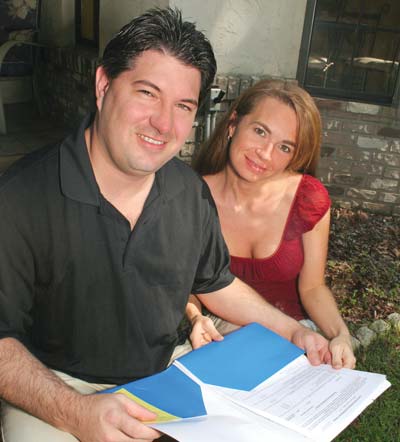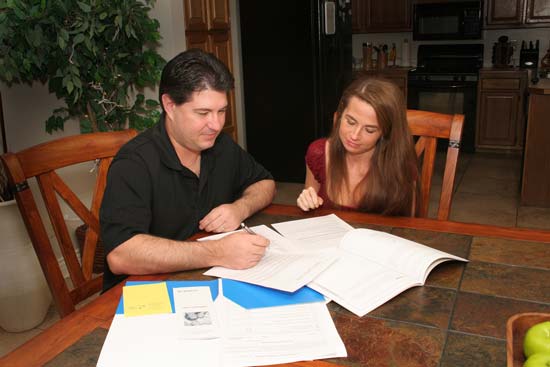
A GREAT GIFT—Chuck and Betty Parkins received an equity gift
from Chuck’s parents to purchase their home.
WHEN OCALA NATIVE CHUCK PARKINS was offered a job in Connecticut, he, his wife Betty, and daughter Brittanie, knew life would be different. They just didn’t realize how different.
“You take Southern hospitality for granted,” Chuck offers, “until you land in a place it doesn’t exist.”
When Chuck was offered a position in Gainesville, they jumped at the chance to return to Florida. They moved in with Chuck’s parents and initiated a search for the house of their dreams. But during their time in Connecticut, the Marion County real estate market had undergone rapid appreciation. They were disappointed but determined to realize a successful house hunt.
Chuck and Betty created a list of requirements for their new home, contacted financial institutions, comparison shopped, and were pre-approved for a loan amount. After working with three real estate agents, Chuck and Betty discussed their difficulty in finding a suitable home with Chuck’s parents. The elder Parkinses, who had been toying with the idea of downsizing, broached the idea of selling their home to Chuck and Betty. The house was perfect—large, in a great location, and complete with a spacious workshop that could easily be turned into an efficiency for Betty’s mom.
“The options for financing were overwhelming,” Chuck says, but quickly adds that Debbie Hart, their loan officer, was “a great source of information.”
When Hart found out that Chuck and Betty were buying their home from Chuck’s parents, she suggested an additional option: equity gifting. An equity gift is actually an equity transfer of up to 10 percent of the appraised value of the home. This option allowed Chuck and Betty enough equity in the home to forgo private mortgage insurance. Because they had done their homework, the closing process was accomplished quickly, and Chuck, Betty, and Brittanie are now happily decorating their dream home.
Initial Financing Options
If Chuck and Betty’s story inspires you to begin the search for your dream home, the following primer will give you vital information on how to get your financial house in order. The first steps in the house hunting process involve homework!
1. OBTAIN YOUR FICO (Fair Isaac Corporation) score and credit reports from all three national credit bureaus: Equifax, Experian, and TransUnion. FICO, with its rating on a scale from 330 to 830, identifies your credit worthiness. The higher your score, the better your interest rate. Both your FICO score and credit reports are available through myfico.com. Review the credit reports, rectify errors, and pay off credit cards.

BE REALISTIC when determining an affordable mortgage.
2. TAKE STOCK OF YOUR FINANCES and down payment. Lenders expect a 5-20% down payment. A 5% down payment on a $200,000 home will be $10,000, leaving a $190,000 balance, while 20% will equal $40,000, and result in a $160,000 balance. The bigger the down payment—the lower the eventual mortgage. If the down payment is less than 20%, you will need private mortgage insurance (PMI). The lender requires PMI to ensure that you will not default on your mortgage, and it adds to the total monthly mortgage payment.
3. DECIDE ON A COMFORTABLE MORTGAGE amount and the monthly payment. The lending rule of thumb is that the total monthly mortgage payment should be between 28-33% of your gross monthly income while a realistic and sustainable level is around 25%. Numerous mortgage calculators are available on the Internet that identify your range based on your salary. In addition to principle, the monthly payment you make against your loan balance, and interest, the amount you pay to the bank to use their money (P and I in mortgage lender lingo), your payment will include 1/12 of your yearly property tax and 1/12 of your yearly homeowner’s insurance. The lender collects this money each month and deposits it into an escrow account. Homeowner’s insurance and property taxes are paid from this account once a year by the lender.
4. KNOW THE DIFFERENCE between pre-qualified and pre-approved. To pre-qualify for a loan, the lender estimates how much money you can borrow based on your income, debt, and down payment. Pre-approval is more rigorous. The lender requests your tax returns, pay stubs, three months’ worth of bank statements, and your down payment verification. The lender pulls your credit reports and FICO score. The lender then promises, in writing, to approve a mortgage amount.
5. SEARCH THE INTERNET to take a preliminary look at the housing market to ensure realistic price expectations. Sites like realtor.com are equipped with search engines that allow you to search by zip code, price range, square footage, number of baths and bedrooms, and any number of other criteria.
6. COMPARE MORTGAGE RATES and good faith closing cost estimates from potential lenders. Check myfico.com to see current interest rates for your FICO score range. Some lenders tack on large origination fees, title insurance rates, and document preparation fees, often referred to as junk fees, so compare to ensure that you get the best deal on closing costs.
7. KNOW MORTGAGE TERMS. The majority of mortgages have 15- to 30-year terms, but new products are being offered by lenders that have 40- and 50-year terms. Although the longer terms allow a buyer to qualify for a higher loan amount, the longer you finance the mortgage amount, the more interest you pay. A 15-year term for a mortgage will carry higher P and I, but the interest paid over the life of the loan is significantly less than for longer terms.
8. UNDERSTAND TYPES OF MORTGAGES: fixed, adjustable and balloon. Fixed mortgages are the steadiest of the products available. The P and I you pay remains the same over the life of the loan. While property taxes and homeowner’s insurance will likely increase during the life of your mortgage, the P and I will remain constant. An adjustable rate mortgage (ARM) usually carries a lower introductory interest rate, so the mortgage amount you can qualify for is higher. The catch with an ARM is the interest rate can fluctuate over the life of the loan. The P and I increases or decreases, but it will have a ceiling that the interest rate cannot exceed and a floor below which the interest rate cannot drop. Balloon mortgages carry 5- to 7-year mortgage terms at the end of which the balance of the loan is due. The borrower can either refinance the balance at the end of the term or pay the loan in full.
Additional Financing Options
If you already have a home, but need to remodel, the following information may come in handy. Each of these financing options requires loan closing costs and fees.
1. REFINANCING. Refinancing is actually the process of replacing your current mortgage with a new one. Refinancing is viable if you wish to:
- Reduce your current interest rate or length of mortgage. The usual rule of thumb is to refinance if your mortgage interest rate is 2 points higher than the current interest rate and you plan to stay in your house for at least three years. When you refinance to a lower interest rate, you can either enjoy lower monthly payments or reduce the loan term. At a two point interest rate reduction, you can often move from a thirty year to a fifteen year term for about the same payment.
- Cash out refinancing. Take advantage of the equity in your home by refinancing and receiving cash at closing. The cash can finance a remodel or pay for major purchases. Some homeowners choose this option since much of the interest on home mortgages is tax deductible.
- Switch from an Adjustable Rate Mortgage (ARM) to a Fixed Rate.
2. HOME EQUITY LOANS. A home equity is a second mortgage. The equity in your home serves as the collateral to secure additional cash. The amount you are eligible to borrow depends on the amount of equity you have in your home, your income, and your credit history. Home equity loans fall into two major categories, closed end and open end. In a closed end home equity loan, after the loan closes, you receive a lump sum. The home equity loan will have a set time period over which you repay the loan. In an open end home equity loan, you decide how much and when to borrow. This type of loan works as a revolving line of credit. You use the equity in your home to borrow the amount you need, when you need it. The payment depends on how much and how often you borrow against the equity. 






